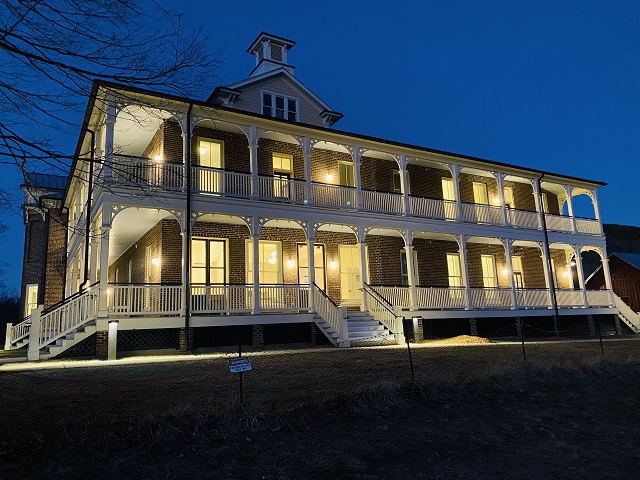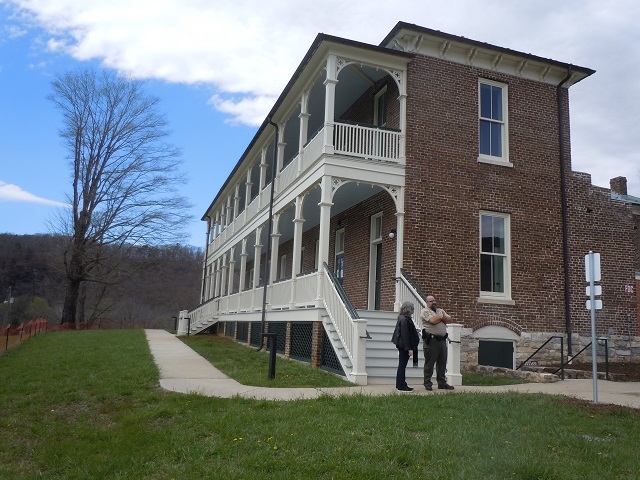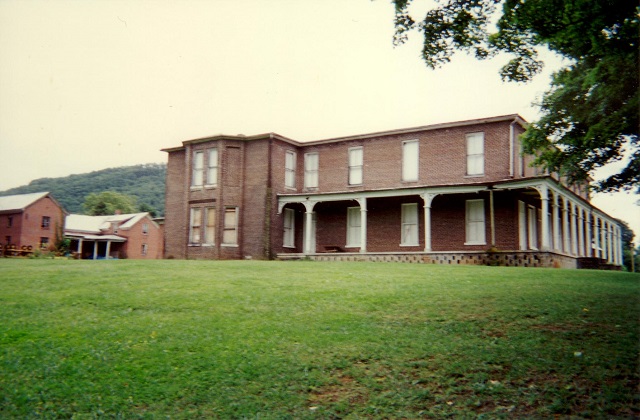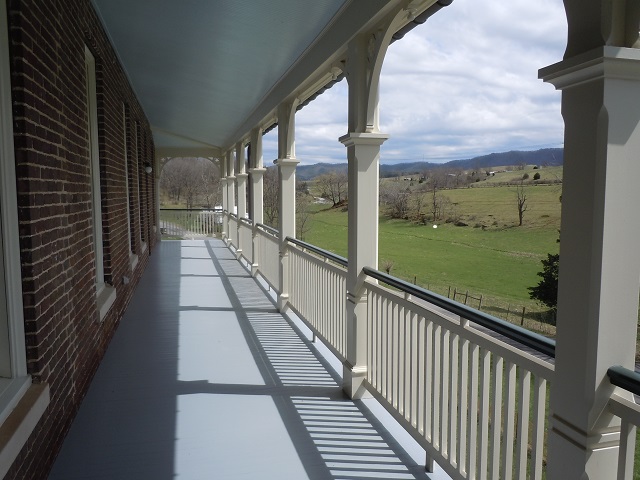
 Department of Conservation and Recreation
Department of Conservation and Recreation
Conserve. Protect. Enjoy.
 Department of Conservation and Recreation
Department of Conservation and Recreation
By Rebecca JonesPosted July 12, 2022

After half a century of silence, a 19th century hotel will come back to life in the next year or so, thanks to a major renovation by the Virginia Department of Conservation and Recreation.
DCR’s Department of Planning and Recreation Resources has been restoring this long-abandoned structure, which has pride-of-place in the middle of New River Trail State Park.
When the building reopens as the Inn at Foster Falls, it will be the only inn in the Virginia State Park system. The full-service, 10-room inn will have stately banquet and meeting rooms, a catering kitchen and huge, two-story porches.
“Our challenge with a project like this is to make it usable for modern times, while also honoring and preserving as much of this building’s unique history as we possibly can,” said DCR Director of Planning and Recreation Resources Kelly McClary.
 New River State Park Ranger Timothy "T.J." Nolen shows a visitor the exterior of the inn, which is currently being restored. When it opens in the next year or so, it will be the Virginia State Park system's only inn.
New River State Park Ranger Timothy "T.J." Nolen shows a visitor the exterior of the inn, which is currently being restored. When it opens in the next year or so, it will be the Virginia State Park system's only inn.
The birth — and decline — of a village hotel
The Inn at Foster Falls has had several lives.
The Foster Falls iron furnace opened in 1881. The Norfolk and Western Railway freight station opened five years later, spurring business and new construction in the area. The hotel opened in 1887. By 1895, the Village of Foster Falls also had a post office, general store, distillery and about 100 houses.
But when the iron furnace closed in 1914, business disappeared, according to local historians. At the end of the First World War, the hotel became an industrial school where girls learned cooking, sewing and other domestic skills. After the Great Depression, it became a co-ed orphanage, with girls residing in the former hotel and boys living in a separate brick house.
The orphanage moved to Wytheville in 1962, leaving the village a ghost of its former self.
“It’s interesting to imagine that transition. A building that over the years was used by hundreds, even thousands, of people was now abandoned,” said Sharon Bledsoe Buchanan, Virginia State Parks Southwest Region Manager.
Fast forward to 1986, when the New River Trail State Park opened across 57 miles of the former railroad tracks that had helped make Foster Falls a destination. The opening of the park gradually brought new attention to the old hotel situated almost in the center of the trail.
DCR acquired the hotel property in 1995. The Village of Foster Falls was added to the National Register of Historic Places in 2005.
“I can remember when it was all shuttered up and derelict. Every door, every window, had plywood over it. It seemed lonely,” said Virginia State Parks Western Operations Manager David Collett. “Time has taken a toll on a lot of buildings in this area. We’re fortunate that we had the opportunity and resources to save this one. So many historic buildings aren’t that lucky.”
See more images of Foster Falls over the years in this slideshow by the Virginia Department of Historic Resources.
 The old hotel at Foster Falls before any restoration was done. "It seemed lonely,” said Virginia State Parks Western Operations Manager David Collett. “Time has taken a toll on a lot of buildings in this area."
The old hotel at Foster Falls before any restoration was done. "It seemed lonely,” said Virginia State Parks Western Operations Manager David Collett. “Time has taken a toll on a lot of buildings in this area."
A new life for an old building
When DCR began the multi-year process of saving the Inn at Foster Falls, job one was stabilizing it – essentially creating a watertight building envelope that included a new roof to prevent further deterioration.
McClary and her team also created an office and maintenance area outside the historic district. “Otherwise you have a glamorous hotel with trailers outside it,” she said.
Further research revealed that what was thought to have been a two-story hotel was actually three stories until a fire in 1940 destroyed the top floor and porches. “We had to decide which era we wanted to restore it back to,” McClary said.
The project would need an army of specialized contractors because of its historic nature. McClary required all applicants to submit samples of multiple successful restorations. She hired Greg Holzgrefe, an architect experienced with the historic renovations, as project manager.
Holzgrefe led the design, from stabilizing the exterior and new site work to the current phase of interior renovation and furniture selection. He ensured a true-to-the-era standing seam metal roof and recreated the original roofline, which included a vented cupola and two styles of dormers. The old two-story porches were also recreated with wooden columns, decorative pierced brackets and ball finials.
The design team used vintage photographs of the hotel and orphanage to capture the appearance of the roofline and porch.
Most of the original handmade bricks were in good condition and were simply cleaned and repointed. However, before any new brickwork was installed, the contractor submitted small mock-ups to ensure the color, texture and design were a good match to the existing brick.
 A view from the newly restored second-story porch.
A view from the newly restored second-story porch.
Stepping inside, building for the future
The interior was a full-gut renovation, but a few of the original components were saved, including an original stair and a few walls of tongue-and-groove wainscoting on the first floor. For everything else, the team made sure the rooms had a 19th century feel but with modern functionalities.
The bathrooms have period tilework designs, often combined with glass showers and other modern amenities. Working fireplaces in the parlor and honeymoon suite look as they did in 1887, but run on gas, not coal. Antique and reproduction furnishings still allow for conveniences such as queen- and king-size beds, mini-fridges, microwave ovens and televisions.
Behind all of these finishes are efficient, state-of-the-art electrical, HVAC and plumbing systems.
The construction is complete, but the inn is not quite ready to open. After a competitive bid process, DCR has selected a concessionaire to run the facility. Furniture and finishes have been ordered, but most of it has yet to be delivered.
The team is certain it will be worth the wait.
McClary said she is looking forward to staying in the inn. But like others who worked on it, she’s also taking a longer view.
“After many, many years of planning and paperwork and labor, it’s incredibly moving for us to be able to point to something that wasn’t there before,” she said. “You can see what you’ve done and know that it will be there for future generations.”
Categories
Recreation Planning | State Parks
Tags
rivers | scenic rivers | state parks

